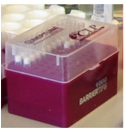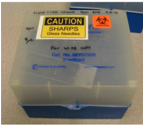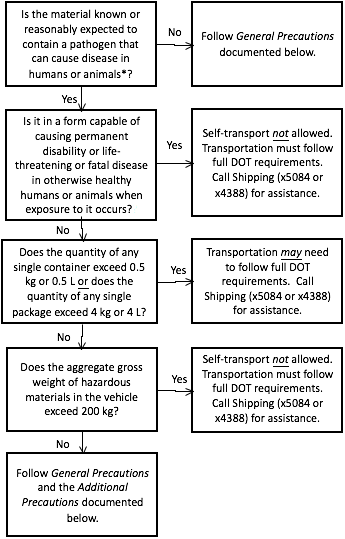Jump to a section
Hand-Carry
Staff may hand-carry biological and infectious substances between adjacent buildings and in connecting spaces (i.e., hallways, stairs, etc.) within buildings provided it can be done safely. Basic precautions must be taken to minimize the likelihood of a spill or the spread of contamination to include:
- Primary and secondary containers must be used. The primary receptacle, secondary container, or both must be leak proof. In addition:
- Primary receptacles should be break-resistant, securely closed and disinfected on the outside.
- Racks or packing should be used inside secondary containment as needed to keep the primary containers upright.
- Remove gloves and wash hands after preparing biological materials for transport. Lab coat, clean gloves, and eye protection should be worn during transport if there is a risk of unexpected exposure, contamination, or spillage.
- Do not transport biological substances through community areas such as break rooms and bathrooms.
Unless materials will be in the continuous possession of the transporter, label the receptacles with the identity of the contents, ownership information including a phone number, and any appropriate biohazard information. When Risk Group (RG) 2 or bloodborne pathogen (BBP) materials are transported, a biohazard label must be displayed on the exterior of the outermost container.
  |
Examples of combination packaging |
Biological and infectious substances hand-carried further distances between non-adjacent buildings should be packaged to a higher level of integrity. As a best practice, package these substances following the General Precautions listed under the Self-Transport by Vehicle
References
- PUB-3435E, Biosafety Manual
Self-Transport by Vehicle
Staff are authorized to personally move (self-transport) small quantities of most biological substances by vehicle provided they use simple controls to prevent spills and the spread of contamination. The following flowchart will help staff determine if the materials can be self-transported and which controls must be followed.
Controls & Limits – Self-Transport of Biological Substances by Vehicle

*Click here for additional clarification.
General Precautions
General precautions are best practices designed to minimize the likelihood of spills or leaks and to communicate important hazard information to others. This includes use of primary receptacles and outer packaging (e.g., combination packaging) that is marked with basic information.
Primary Receptacles
- Primary receptacles should be break-resistant, leak proof for liquids, and sift proof for solids. Primary receptacles for liquids should also have a positive means of closure (a screw cap, skirted stopper, metal crimp seal, etc.).
- Primary receptacles should be disinfected as needed for safety.
- Primary receptacles should be placed in a secondary container (i.e., a Ziploc® bag) to contain spills.
Outer Packaging
- Outer packaging should be a strong and tight packaging (ice chest, enclosed laboratory tube carrier, etc.).
- Outer packaging should be securely closed.
- Outer packaging for primary receptacles containing liquids should contain sufficient absorbent material (cellulose wadding, cotton balls, super-absorbent packets, paper towels, etc.) to absorb the entire contents of the inner packaging.
- Packing materials or racks should be used as needed to keep primary receptacles upright, cushion the container, and prevent the container from shifting or damage.
- Outer packaging should be placed inside the vehicle to secure it against shifting during travel.
- Containers for sharps (i.e., sharps containers) should be constructed of a rigid material resistant to punctures and securely closed to prevent leaks or punctures.
Marking
- Mark both the inner packaging and outer packaging with:
- Common name of the material.
- Name and phone number of the sender and recipient (if different than the sender).
- Hazard information (including a biohazard label if the material is biohazardous or a statement indicating the material is not hazardous).
Additional Precautions
Staff may self-transport biological substances that are infectious but are not in a form capable of causing permanent disability or life-threatening or fatal disease in otherwise healthy humans or animals when exposure to it occurs, must follow additional precautions as follows:
- Follow all of the recommendations listed under General Precautions (except for break-resistance and secondary containment which are still recommended best practices).
- Use the manufacturer’s original packaging, or a packaging of equal or greater strength and integrity.
- Modify your JHA to indicate you self-transport infectious biological substances
- Simply add a sentence to your description of work until new JHA questions reflect this activity.
- Complete EHS0657, Self-Transporting Haz Mat (as of May 2013, this is a recommended course only).
- Complete EHS0739, Biosafety for Researchers
- Inform the driver/passengers of the infectious substances being transported and the safety controls in place.
- As a best practice, print a copy of the LBNL “Materials of Trade” disclaimer and keep it with the hazardous material during transportation.
Prohibitions
Self-transportation of any biological substance that is infectious or potentially infectious (or a medical/biohazardous waste or any other biological material that may present a detrimental risk to the health of humans or other organisms, either directly through infection or indirectly through damage to the environment) on the shuttle bus is prohibited.
Dry Ice
Dry ice is not regulated as a hazardous material when simply transported in a vehicle. Do not place dry ice inside outer packaging that is gas-tight. Transport packages with dry ice in the bed of a pickup truck if feasible. If packages with dry ice must be transported inside a vehicle, roll down all windows during transport and minimize the amount of time the dry ice is inside the vehicle.
Resources Available to Staff
Staff can always contact Shipping (x5084, x4388 or shipping@lbl.gov) to request transportation assistance. If requesting transportation assistance, provide at least 72-hour notice to Shipping.
References
- Department of Transportation – 49 CFR Section 173.6
- PUB-3435E, Biosafety Manual
Ship by Common Carrier
Shipping requirements are different from self-transportation requirements. Some items like dry ice and lithium batteries that are not regulated for self-transportation in a vehicle are regulated when shipped in commerce.
Contact Shipping (x5084, x4388, or shipping@lbl.gov) to arrange for shipment including pick-up and same day shipments. Please note that same day shipments must be at Shipping before 12:00 P.M. Shipments requiring next day delivery in the U.S. must be at Shipping on or before 2 P.M.
Conduct Field Work
Self-transporting hazardous materials to or from the field follows the same requirements documented under Self-Transport by Vehicle.Shipping to the field follows the normal shipping process. However, if hazardous materials must be shipped from the field, contact Shipping (x5094, x4388, or shipping@lbl.gov) as early as possible to plan for this activity. Depending on the specific activity, additional training and controls may be required.

